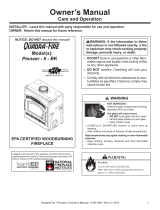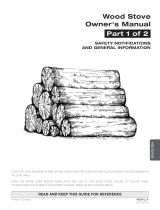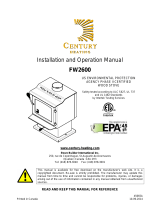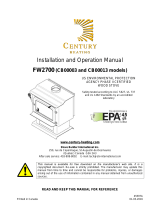
ESSE Stoves, PO Box 4, Long Ing, Barnoldswick, Lancashire BB18 6BN
Website: http://www.esse.com
TH E OR IGINAL CAST IRON COOKER
12/07
ESSE Woodfired Cooker
FLUE WAY MAINTENANCE & WOOD BURNING GUIDELINES
MODEL: WN, WD, W23, EW & EWB

INTRODUCTION
By burning properly
seasoned firewood and
following this simple
maintenance guide your
Woodfired cooker will
reward you with a lifetime
of trouble free performance
3
Your Woodfired cooker is a highly developed and precisely engineered piece of
cooking equipment that is designed to perform to an exceptionally high level. It
can run continuously and offers its experienced user an excellent degree of
control over oven temperatures and fuel consumption.
When connected to a suitable and properly functioning flue (see installation
instructions), the firebox at the heart of the cooker is highly efficient but will still
produce a small amount of fine soot particles that are carried around the
cooker’s flue ways and will occasionally need removing.
If the simple cleaning and maintenance guidelines in this booklet are followed at
the prescribed intervals, your cooker will provide , trouble free performance year
after year and reward you with environmentally friendly cooking and heating with
minimum fuss.
2
The successful operation of your Woodfired range cooker is entirely dependent on the adequate
performance (pull) of the chimney or flue to which it is connected. The following maintenance
guidelines will be pointless unless the flue is also maintained and cleaned regularly. How often it needs
cleaning will depend on the quality and moisture content of the wood you burn but an annual clean is
recommended. A partially blocked or dirty flue can have disastrous implications for an otherwise
perfectly installed cooker as can bee see below. Cooker A has been used regularly for over a year
following these maintenance guidelines and with a clean flue drawing correctly. Cooker B was just 6
weeks old when the picture was taken and shows how quickly tar deposits will build up if the flue
performance is poor and clogged with old soot as it was in this case.
THE IMPORTANCE OF A HEALTHY FLUE
☺
☺
Healthy flue
The flue draught meter shows a
healthy reading (between 12 &
24 pascals) which is ideal for
optimum firebox performance
A
B
Unhealthy flue
The flue draught meter shows a
reading well below the required
operating range that will result in
a poor, smokey performance
Good draft & clean flue =
efficient wood burning,
clear flue ways, minimal
soot and no tar deposits.
Poor draft & dirty flue =
inefficient wood burning,
blocked flue ways, lots of
soot and tar deposits.

5
CLEANING THE FLUE WAYS - Every 3 months
Always carry out cleaning procedures when the cooker is out and has been allowed to cool sufficiently to
avoid burns. With time and experience you will be able to gauge the intervals between flue way cleaning
more accurately. It will vary depending on the quality of your firewood and performance of your flue. Take
time to get to know your cooker and inspect it at regular intervals for the first 6 months.
We recommend that a flue brush of the type shown below (Fig B) is used to clean the flue ways. Its flexible
wire handle is ideal for pushing the brush head round bends and into narrow spaces.
HOT PLATE AND PRIMARY FLUE WAY
Remove the hotplate securing screws and use the hotplate lifting tools (Fig A) that came with your cooker
to remove the hotplate and if required give the surfaces under the hotplate and above the firebox and top
oven a light scrub with a wire brush and vacuum out any debris.
FLUE BOX AND REAR FLUE WAY
Remove the front of the flue connector box and insert the flue brush from left to right, angling the brush down
at 45˚. Once you find the flue way entrance push the brush down until it stops then gently but firmly pull
back and forth 3 or 4 times then remove the brush. Dislodged soot will fall into the tray between the ovens.
RIGHT SIDE FLUE WAY
Next insert the brush at a shallow angle as shown above. The brush will need to turn 90˚ into the flue way
so steady pressure will be needed to help the brush head round the bend. Once in, work the brush up and
down and front to back as the flue way runs along the entire depth of the ovens. Again, soot will fall into
the trap between the ovens.
4
Fig B
Lightly brush surfaces with a
wire brush and vacuum up
debris. Lift hotplate with care
and place on newspaper or
an old sheet.
Fig A

76
CLEANING THE FLUE WAY BETWEEN THE OVENS
Remove the inspection cover and insert the cleaning brush, sweeping from side to side and making sure
the brush reaches the back corners of the flue way on both sides. Careful remove the brush to avoid
dragging soot out of the inspection cavity.
SOOT REMOVAL
Finally place a bucket as shown above and carefully rake out the loose soot using the tool that came with
the cooker. Take care to reach into the corners using slow deliberate strokes to avoid dust. It may also be
possible to insert a vacuum hose into the cavity for a really good dust free clean. A well run cooker and
healthy flue should produce no more than the amount shown above in 12 months.
It is essential to maintain the integrity and cleanliness of the flue to ensure that your cooker continues to
perform at its best. When your cooker was installed the main flue should have been equipped with an
inspection hatch; either in the blanking plate above the cooker next to the flue pipe (Fig C) or in the flue
pipe itself. These hatches are designed to allow periodic access to the flue for cleaning which should
ideally be done by a chimney sweep.
Chimneys and flues vary widely in terms of size, shape, length and construction, but the principles of the
way they work are the same. Keeping them clean and clear is essential to maintain the optimum
performance of any woodburning or multi-fuel appliance.
This is the amount of soot removed
from the flue ways of a continuously
used cooker with a healthy exit flue
using properly seasoned fire wood
over a period of 12 months.
CLEANING THE EXIT FLUE - Every 12 months
Fig C
Blanking plate
6” flue pipe
connected to
exit flue
Inspection hatch
in flue pipe
Inspection hatch
in blanking plate
Fig D
6” flue pipe
connected to
exit flue

THE BURNING PROCESS
Understanding what happens when wood is burnt will enable you to burn wood in a more environmentally
friendly way, reduce the maintenance required for your chimney and get more out of your wood. There are
3 stages in the wood-burning process:
Evaporation - When you light the cooker a lot of energy will be needed at first to boil away any moisture,
which is left in the wood. Using energy to drive off excess water in firewood robs the cooker of energy
needed for an efficient and clean burn. Also, much of the energy wasted in evaporating water is energy
that could have heated the hotplate and ovens. This is a waste of wood, money and effort.
The presence of all that moisture tends to keep "putting out" the fire, and therefore making it burn very
poorly, which tends to produce a lot of creosote and pollution.
Please see the section on page 10 on seasoning and storing wood, which can help to minimise these
problems.
Emissions - As the heat of the fire intensifies, waste-gases (smoke) are released from the wood.
Unburned smoke is emitted into the air either as pollution, or condensed in the chimney causing creosote
build-up. It takes time for the air in your chimney to heat up. When it is still cold you get an effect similar
to the condensation of hot breath on a colder window or mirror. So when the by-products of combustion
(smoke in the form of gases) exit the cooker, and flow up into the relatively cooler chimney, condensation
occurs.
The resulting residue that sticks to the inner walls of the chimney is called creosote. Creosote is formed
by unburned, flammable particulates present in the smoke. It is black or brown in appearance. It can be
crusty and flaky, tar-like, drippy and sticky or shiny and hardened. Quite often, all forms will occur in one
chimney system (see an extreme example of this on page 3).
If the wood you are using is water logged, or green, the fire will tend to smoulder and not warm the chimney
sufficiently. Wet wood causes the whole system to be cool, and inefficient. In contrast: dry wood means a
hot fire, which results in a hot flue, and a hot flue means much less creosote clogging up your chimney.
The Woodfired cooker’s firebox is designed to operate at very high temperatures to burn the gases and
particles released from the wood, which means less air-pollution.
The air supply to the afterburner in your cooker is always open but works most effectively in conjunction
with a hot fire. We strongly recommend running the cooker up to a high temperature at least once per day.
Charcoal - When most of the tar and gasses have burned the remaining substance is charcoal (ash in it’s
finer form). A hot bed of charcoals and ash can enhance the combustion process when burning larger
pieces of wood. Start with a small fire to develop a bed of glowing embers. As the charcoal bed develops
and the cooker heats up, slowly add larger and larger pieces of wood. It takes time to build a good
charcoal bed, but it is well worth the effort. only empty excess ash periodically and always leave a bed of
ash on which to light the next fire.
WHAT TYPE OF WOOD IS BEST
The difference between 'hard' and 'soft' woods is the density of their cells or fibres. The harder a wood, the
greater the density and quantity of fibres in any square inch of that wood.
As a general rule, the deciduous trees (those that lose their leaves in the autumn) are usually thought of
as hardwoods and the evergreen trees (such as pines, firs and larches) as the softwoods. But
generalisations are of course always subject to many exceptions. Some evergreens may well be harder
than some deciduous trees. Birch, for example, is not very hard at all. So we should understand that there
is a whole range of densities amongst our tree species, including medium dense woods, which cannot be
satisfactorily classed as hard or soft.
For construction purposes and different wood working projects, the shape and arrangement of the
individual cells and its growth patterns are also important considerations, but when judging the value of a
bit of wood for its use as a firewood, we look especially at the density of fibres.
One of the reason for this is that firewood tends to be sold by volume rather than weight. Assuming that
the wood is reasonably dry, the weight of a square foot of good hardwood may be double of that of a
square foot of softwood. This means that the same volume of hardwood will provide you with more fuel to
burn than an equal amount of softwood, simply because it contains more substance.
Yet the price of that hardwood will normally not be double that of softwood, because it took the same
amount of labour to prepare. So, if a trailer full of softwood costs £100 and the same size trailer full of
hardwood costs £120, the more expensive option may well be the most economical.
The other advantage of good hard firewoods are that the cooker does not need to be fed as often and the
charcoal-beds made by the glowing wood may burn more easily overnight.
However, the ideal situation would be to have a store of both hard and soft woods, because the softer
woods also have distinct advantages. They light more easily than the slower burning hardwoods and if the
softwoods are dry, they create a hotter, more intense fire. The draught created by the hotter fire moves the
air up the chimney faster.
After reading the notes opposite about the burning process, you will understand that means less pollution
in the form of smoke and less creosote condensation in your chimney.
The denser hardwoods tend to smoulder more easily when the fire is lit first, so their flue gas temperature
will be much cooler.
Because softwoods like pine and larch contain a lot of resins and pitch, a popular misconception is that
CHOOSING THE RIGHT WOOD & WOOD BURNING GUIDELINES
98

they will fur up the chimney with creosote more easily than a hardwood like oak. This is not necessarily
true at all. It is not the pitch that is the problem, it's the water IN the pitch. Once the water in the wood has
evaporated, that pitch becomes high octane fuel! When dry, softwoods burn extremely hot!
There is also the matter of seasoning (drying out of the wood - please see below) to be considered. When
you buy wood, it will usually have been cut in the winter of the year you buy it. Hard woods tend to take
longer than softwoods to fully dry out.
Softwoods cut in the previous winter should, with proper storage, be ready to burn the next autumn,
whereas many hardwoods may take a bit longer than that. Oak, for example, is very slow to dry out and
ideally left for two years. It is also possible to purchase pre seasoned wood.
Summarising we can say that it is always sensible to buy this year for next years fuel supply and that it is
very handy to have both soft and hardwoods. You can use the softwoods to start a good fire and you will
have additional control over the fire (in addition to the cookers controls) by adding slower burning wood
to fast ones if you want to leave the cooker without tending it for a while. Alternatively you can add some
fast burning softwood logs to the slower hardwood logs to instantly revive a fire, which has been
neglected.
SEASONING AND STORING FIREWOOD
Wood, which has recently been cut and is still full of
sap and water is known as "green" wood.
Greenwood will generally burn poorly and
inefficiently, because it can have from 50% water
(for example: Ash) to as much as 140% water (for
example: Elm) in its cells. It may be hard to light,
smoulder, not put out any heat and cause more than
the usual amount of creosote to build up in your
chimney.
So your aim should be to dry the wood out to below
25% moisture content, this process is called
seasoning. As the name implies, you should store
your wood for a season or so, while it dries, but
there are things you can do to speed up seasoning
by cutting the wood now rather than just before you use it.
Wood is composed of bundles of microscopic tubes that were used to transport water from the roots of
the tree to the leaves. These tubes will stay full of water for years even after a tree is dead. This is why it is
so important to have your firewood cut to length for 6 months or more before you burn it, it gives this water
a chance to evaporate since the tube ends are finally open and the water only has to migrate a foot or two
to escape. Splitting the wood helps too by exposing more surface area to the sun and wind, but cutting
the wood to shorter lengths is of primary importance.
Here’s how you can tell whether your wood is ready or not: Well seasoned firewood generally has
darkened ends with cracks or splits visible, it is relatively lightweight, and makes a clear "clunk" when two
pieces are beat together. Green wood on the other hand is very heavy, the ends look fresher, and it tends
to make a dull "thud" when struck.
Another thing you can do to help is store your wood properly. Store if off the ground by building the pile
on some longer logs (or whatever method you can devise). A shed or shelter with an open side makes an
ideal storage place, as the air can circulate around the logs and help to dry them out. Unventilated spaces
or plastic tarps, which never get taken off will prevent the drying and evaporation process and cause
moulds and rot. So, if a tarp is your only option, take it off frequently to air the wood on fine days. And
remember to put it back on again. Seasoned firewood will reabsorb large amounts of water if exposed to
rain, snow and excessive dew, which is liable to make it rot and be unfit for making a good fire.
When you build up a store of firewood, remember that the wood may start to deteriorate after 4 to 5 years,
although this is of course variable and depending on storage conditions and species involved.
OPERATING TIPS
By taking time to get to know your cooker, following our maintenance guidelines and using good quality
firewood you should enjoy trouble free operation of your Woodfired cooker but it is also worth bearing in
mind these useful operating tips:
G Don’t leave the cooker lit for long periods in slumbered down mode (as you would for overnight
burning), open the primary air control and bank up the fire periodically to heat up the cooker and flue
to prevent soot build up.
G Cut your logs to the size shown in Fig E to minimise the need for refuelling.
G Always leave a decent ash bed of between 3 - 5 inches in the base of the firebox. This an ideal base
on which to burn logs.
1110
19cm
45cm
Fig E
-
 1
1
-
 2
2
-
 3
3
-
 4
4
-
 5
5
-
 6
6
Esse EW Maintenance Instructions Manual
- Type
- Maintenance Instructions Manual
- This manual is also suitable for
Ask a question and I''ll find the answer in the document
Finding information in a document is now easier with AI
Related papers
-
Esse 990 CH Operating Instructions Manual
-
Esse Plus 1 Operating instructions
-
Esse 990WD Instructions Manual
-
Esse WD Operating instructions
-
Esse Bakeheart User manual
-
Esse WN Operating instructions
-
Esse Firewall 39" Original User Instructions
-
Esse Bakeheart User manual
-
Esse PLUS 1D Instructions Manual
Other documents
-
Heatilator ECO CHOICE WS18-AU Owner's manual
-
Heatilator 42C-6 Owner's manual
-
 Quadrafire 4300 Millennium AU Wood Stove User manual
Quadrafire 4300 Millennium AU Wood Stove User manual
-
Dovre 400 Operating instructions
-
 Quadrafire Pioneer II Wood Fireplace User manual
Quadrafire Pioneer II Wood Fireplace User manual
-
Heat & Glo BIR50 User manual
-
Quadra-Fire Pioneer III Wood Fireplace Owner's manual
-
 Drolet DECO NANO WOOD STOVE User manual
Drolet DECO NANO WOOD STOVE User manual
-
 Century Heating FW2600 Specification
Century Heating FW2600 Specification
-
 Century Heating CB00003 User manual
Century Heating CB00003 User manual










